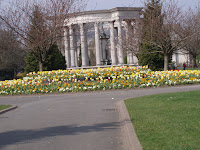
Publishers' Display: This was a bit disappointing--the publishers seemed to have just their most recent texts available. I'm used to seeing larger numbers of books available and being able to take time perusing them. This seemed to be more hard-sell on the few texts being currently flogged!
Exhibition Area: In this section, various colleges were promoting their ESL courses or their TESL programs. It was something I'm not familiar with from the Canadian conferences.
Internet Cafe: One of the publishers hosted an Internet Cafe--a very popular venue. There were always lines of people waiting to use the computers.
The National Museum: Some presentations were in the National Museum; it's another impressive building right next to City Hall. However, it's a more modern building, so there aren't the ornate ceilings, paintings and statues of City Hall.
Evening Programs: There were various programs each evening mainly designed to introduce the delegates to Wales and Welsh culture. I can't comment on these as I didn't attend. Perhaps if I hadn't already spent three years living in Wales and didn't have a number of Welsh relatives, my interest might have overcome my jet-lag.
Crowds: There were some 1600 delegates to this conference--more than had been expected when the planning began. As a result, nost of the sessions were very crowded, and it was difficult getting into some of them. The crowds in-between sessions also made it difficult to get around, find refreshments--water, tea, coffee. But I have to concede that this crowdedness did give an air of excitement.






